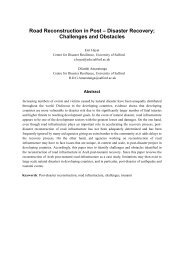Spatial Pattern of Socio-economic Landslide Vulnerability and its ...
Spatial Pattern of Socio-economic Landslide Vulnerability and its ...
Spatial Pattern of Socio-economic Landslide Vulnerability and its ...
Create successful ePaper yourself
Turn your PDF publications into a flip-book with our unique Google optimized e-Paper software.
multiple indicators <strong>of</strong> exposure, coping capacity <strong>and</strong> resilience was applied to derive final consideration <strong>of</strong><br />
l<strong>and</strong>slide vulnerability. Finally, it was classified into low, medium <strong>and</strong> high level <strong>of</strong> vulnerability (Table 1).<br />
Table 1 <strong>L<strong>and</strong>slide</strong> <strong>Vulnerability</strong> Indicators<br />
No. <strong>Vulnerability</strong> Exposure Indicators Coping Capacity Indicators Resilience Indicators<br />
Classification<br />
1. Low 1. Building Material:<br />
traditional brick with<br />
reinforced concrete column<br />
1. Age: dominated by 15-<br />
64 years old<br />
2. Gender: dominated by<br />
1. Income:<br />
>1.500.000 IDR<br />
2. Saving: yes<br />
2. Construction type:<br />
engineered-semi engineered<br />
male<br />
3. Preparedness: well<br />
3. Building<br />
material:<br />
3. Building age: (10 m- 50m)<br />
timber<br />
3. High 1. Building Material: bamboo<br />
<strong>and</strong> timber<br />
2. Construction type: non<br />
engineered<br />
3. Building age: >30 years<br />
4. Infrastructure (distance to<br />
road): low accessibility (>50<br />
m)<br />
1. Age: dominated by 64<br />
2. Gender: dominated by<br />
female<br />
3. Preparedness: poorly<br />
prepared<br />
4. Knowledge <strong>of</strong> l<strong>and</strong>slide:<br />
no understood<br />
1. Income: <<br />
750.000<br />
2. Saving: no<br />
3. Building<br />
material: bamboo<br />
<strong>and</strong> timber<br />
3.2. <strong>Spatial</strong> <strong>Pattern</strong> Analysis<br />
<strong>Spatial</strong> pattern analysis is employed to describe exploratory point sampling data <strong>of</strong> socio-<strong>economic</strong><br />
vulnerability. The data comprises the spatial coordinate data represented in two dimensionally space <strong>and</strong> the<br />
categorical level <strong>of</strong> socio-<strong>economic</strong> vulnerability. Nearest neighborhood, spatial mean centre, st<strong>and</strong>ard<br />
distance <strong>and</strong> directional distribution (st<strong>and</strong>ard deviation ellipse) were employed to show the proximity <strong>of</strong><br />
particular spatial point location in relation with <strong>its</strong> environmental spheres.<br />
Nearest neighborhood technique was employed in order to explore whether the point <strong>of</strong> categorical<br />
socio-<strong>economic</strong> vulnerability looked to be clustered or dispersed visually. It measures the ratio between the<br />
observed distances <strong>of</strong> each point toward <strong>its</strong> nearest point neighbor <strong>and</strong> the expected mean distance for the<br />
point given in a r<strong>and</strong>om pattern. If the ratio is less than 1, it means that the exploratory point sampling seems<br />
to be clustered pattern. In the other h<strong>and</strong>, dispersed pattern is described by the ratio more than 1.<br />
Central feature analysis estimates the average central point location <strong>of</strong> a set <strong>of</strong> particular spatial point<br />
location. It measures the mean centre <strong>of</strong> x-coordinate <strong>and</strong> the mean centre <strong>of</strong> y-coordinate. Mean centre<br />
analysis is useful to show the concentration <strong>of</strong> each categorical socio-<strong>economic</strong> l<strong>and</strong>slide. Therefore, the<br />
tendency <strong>of</strong> the spatial distribution can also be addressed as well. St<strong>and</strong>ard distance describes the<br />
compactness or spatial deviation <strong>of</strong> the point analysis toward <strong>its</strong> central features. It seems likely to be<br />
st<strong>and</strong>ard deviation in traditional statistic. In GIS platform, it is represented by circle feature which has the<br />
radius equal to the st<strong>and</strong>ard distance value. Directional distribution is rather similar with st<strong>and</strong>ard distance<br />
circle. St<strong>and</strong>ard distance circle calculate the st<strong>and</strong>ard distance simultaneously in the x <strong>and</strong> y direction.<br />
However, st<strong>and</strong>ard distance circle cannot pose the directional bias in point distribution. In the directional<br />
distribution, the x <strong>and</strong> y direction is calculated separately. It calculates the st<strong>and</strong>ard deviation <strong>of</strong> the x <strong>and</strong> y<br />
coordinates from the mean centre. The result is axes <strong>of</strong> an ellipse or st<strong>and</strong>ard deviation <strong>of</strong> ellipse which is<br />
drawn as an ellipse feature. Thus, by those techniques, the spatial characteristic <strong>of</strong> categorical point socio<strong>economic</strong><br />
vulnerability such as central tendency, dispersion <strong>and</strong> directional trends can be posed easily.<br />
3.3. Fuzzy Logic Technique<br />
The fuzzy logic technique was employed in order to consider the environmental factor <strong>of</strong> socio<strong>economic</strong><br />
l<strong>and</strong>slide vulnerability represented in a map as members <strong>of</strong> a set. It defines the design <strong>of</strong> a<br />
membership function that expresses the degree <strong>of</strong> membership in respect to the attribute <strong>of</strong> interest. For<br />
4<br />
- 523 -
















